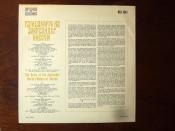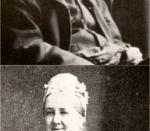Selection: Pomp and Circumstance March No.1
Composer: Edward Elgar (1857 - 1934)
This listening selection can be found in the lesson on "Can Music Have a Specific Purpose". The title of this piece comes from a line in Shakespeare's Othello ("Pride, pomp, and circumstance of glorious war!"), in 1901. This outwardly straightforward music is known as Elgar's most famous piece, as it is often played at graduation ceremonies. But it was not originally intended for graduations. Elgar's march was used for the coronation of King Edward VII
The tune sounds triumphant, bringing to life feelings of majesty. Listening to this piece brings to mind several memories. I recall playing this piece during the days when I was in a marching band. We played this on occasions such as a prize giving ceremony, and during parade inspections on important occasions. This strongly reminds me of my years spent playing in the band, and the chance I was given to be a Drum Major.
I am also reminded of the time when I attended my cousin's high school graduation ceremony. The tune had an underlying quality of nostalgia, making it perfectly suited to a commencement that marks the beginning of one stage of life, but the end of another.
Elgar's musical concept of this piece, from my point of view, is well structured and is able to convey a complex of emotions. The basic structure for the piece is quite simple: a rousing, striding, militant outer section, with a more reflective, solemn inner tune. Like Handel's See Here the Conqu'ring Hero Comes, the piece has two main ideas, A and B. The following is my interpretation of the chronology of the musical ideas:
0:00 to 0:19 - Idea A
0:20 to 0:39 - Idea A
0:40 to 0:49 - Idea B
0:50 to 1:09 - Idea A
1:10 to 1:29 - Idea A
1:30 to 1:38 - Idea B
The piece is composed for an ensemble. It starts off mellow with a few instruments, giving it a very solemn feel. As it progresses, a greater triumphant feel is suggested with the increased in volume and power by adding in more instruments. This changes the dynamics of the piece. The timbre of this piece is played by the violins, which has a very mellow sound in the introduction, and the rich sound with the additions in the second section. With the repetitions of musical ideas, he utilizes excellent variations, thus giving the piece enough variety to keep it interesting, at the same time attaining unity.
The popularity of this march reflects Elgar's ability to compose melodies that convey a complex of emotions. I conclude that this selection is very effective in utilizing unity, variety, dynamics, and timbre.



Error in Level
Please note, level is College - Freshman.
Thanks.
1 out of 1 people found this comment useful.